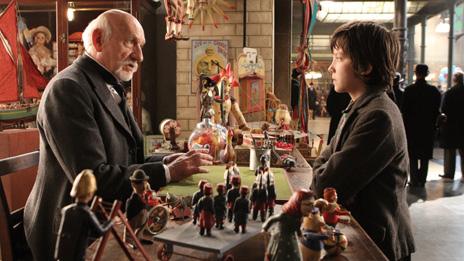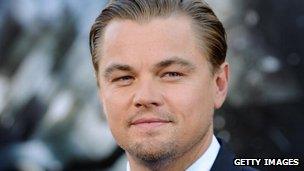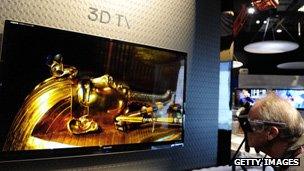Can Martin Scorsese's Hugo save 3D?
- Published

Sir Ben Kingsley and Asa Butterfield star in Hugo, the tale of an orphan with a talent for mending clockwork objects
Martin Scorsese's new film Hugo has been called a watershed for live action 3D film-making, but is it too late to save the format?
It has not been a great year for 3D.
Given a choice between 2D and 3D, film-goers have increasingly been choosing the cheaper option, external. The split is now 60/40 in favour of 3D, compared to 78/22 a year earlier.
Sales of 3D television sets have been sluggish, external, and the price of Nintendo's 3DS console was slashed by more than £100, external, just five months after its release.
It's not just a headache for the entertainment industry. Research by California State University, external found that people watching 3D content were three times more likely to suffer sore heads, eye strain and blurred vision.
It's only two years since Avatar broke box office records - but is the honeymoon over already?
"We are at an absolutely pivotal moment," says Chris Parks of Vision 3, a UK company which advises the film industry on stereoscopic technology.

Avatar made $760.5m (£484m) at the box office
"It was inevitable that the bubble would burst, and it absolutely deserved to burst.
"I have faith in 3D as a medium, but I don't think any live action film has got it right so far."
Some critics suggest Martin Scorsese is about to change all that.
His fantastical family film Hugo, which hits UK cinemas this week, has been branded "the future of 3D movie-making", external.
The most heavyweight director to tackle the technology since Alfred Hitchcock, Scorsese uses 3D as a spectacular storytelling device - pushing the viewer through crowds in frantically-choreographed chase scenes, and breathing life into a clockwork robot that holds the key to the plot.
"I think what Marty's done is push 3D around a corner and given a gimmick a huge amount of heart and potential," says Sir Ben Kingsley, one of the film's stars.
Scorsese is more modest about his first foray into the format.
"We were scared," he says. "It was like walking a tightrope, the whole picture."
When the legendary director, whose credits include Taxi Driver, Raging Bull and The Departed, announced that he was making a 3D film, he discovered that everyone around him had advice... and almost all of it was bad.
"People start to have rules: You can't do this, don't do that," he recalls.
"I said, 'I don't want to hear what can't be done'.
"I'm not usually that intrepid but I wouldn't let people confuse me. If it couldn't be done, we'd have seen it on the set, in the monitor."
The 'glass box'
Scorsese even breaks the unwritten "pointy stick" rule and thrusts objects out of the screen into the audience - a gimmick modern 3D films have sought to avoid.
"I had to have references to the old 3D where things came towards the camera," laughs the director, who is particularly fond of a scene where a snarling Doberman pursues the film's protagonist through a railway station.

Shooting in 3D presented new challenges for Martin Scorsese and his stars
"The muzzle of the Doberman was perfect!" says Scorsese.
"The more we pushed that shot, the more we started laughing. When the muzzle comes towards the audience, it has an attitude. The depth of the shot emphasises that. It underlines it.
"In 2D it's good. In 3D it's better."
Chris Parks, of Vision 3D, agrees that rules are there to be broken.
"Avatar was a landmark," he says, "but I think the way James Cameron approaches 3D is very limiting.
"I'm reluctant to say this without him having a chance to respond - but his tendency is to keep everything behind the screen.
"All that does is draw your attention to the fact that there is a screen. Part of the joy of 3D is that it gives you a volume. Keeping that volume within a glass box doesn't seem right."
Of course, Scorsese is famous for his bravura camerawork - from the rippling, slow motion boxing scenes in Raging Bull to the breathtaking reverse tracking shot in Goodfellas. Can other directors harness 3D in the way he has?
Chris Parks says that, with the likes of Peter Jackson and Steven Spielberg now working in stereo vision, there is hope for the future.
And of the dozens of 3D films set for release next year, the one he is most looking forward to is perhaps the most unlikely - Baz Luhrmann's The Great Gatsby.

Leonardo di Caprio stars in the 3D remake of The Great Gatsby, due for release on 25 December 2012
"3D should be about making you laugh more, cry more or empathise with your characters more - and that's what The Great Gatsby is about," he explains.
"Imagine a single shot of a close-up of a person's face. A head and a neck, with a subtle change of expression - a moment of realisation, a flash of guilt, or even just a held stare - it is incredibly powerful.
"Humans are very good on picking up those signals - that's how we've evolved and managed to stay alive. I believe that filming people's faces in 3D will help to communicate that."
Television transformation
The question remains: Can cinema-goers be tempted back into those oddly uncomfortable glasses, after a rash of poor-quality blockbusters like Clash Of The Titans and Green Lantern - all of which were converted into muddy, pop-up book 3D after filming had finished?
"It's inevitable that a few years after Avatar that the 3D craze was going to settle down," says Mark Batey of the Film Distributors' Association.
"And that's all that's happened - it's become just another option at cinemas around the country. But where a film is released in 3D, it still accounts for more than half of the box office."

Ofcom says 3D TVs accounted for only 1% of all sets sold in the UK in 2010
Statistics compiled by the British Film Institute show that, when a movie is conceived, designed and filmed specifically for 3D, audiences are more likely to choose that option over the flat-screen version.
But some film-makers are concerned that pushing the technology will shorten the life-span of their work.
"When a film gets reduced to a Blu-ray or a DVD, that's where it will live forever," says Gareth Edwards, director of the critically-acclaimed independent sci-fi film Monsters.
"But it's hard to imagine that 3D Blu-ray or 3D television will take off when you have to wear glasses.
"Are people going to walk around their houses with the glasses on, just on the off chance that the TV catches their eye and they want to look at something? I don't think so."
Andy Vandervell from Which? Magazine agrees that 3D television is a long way from becoming commonplace.
"Outside of the home cinema enthusiasts, there isn't a great deal of desire for it," he says. "The experience with the heavy glasses and the cost are prohibitive."
Indeed, he says the consumer magazine would not currently advise people to buy a TV just to get hold of 3D content, because there is so little of it around.
"There are lots of TVs we do recommend that support 3D," he says, "but it's always an additional benefit."

Manufacturers are working on ways to make the ubiquitous 3D glasses obsolete
Parks believes the next generation of 3D technology could be more attractive for home consumers.
"Companies are working quite heavily on glasses-free 3D TVs," he says.
"They're very much in the prototype stages but we've seen quite a few of these models now."
The sets may take some time to reach customers, however, as the glasses-free screens tend to compromise regular TV and DVD pictures.
"I guess they won't go to market until they've solved that problem," says Vandervell.
Edwards, however, is sceptical that banishing the bulky grey headsets would stimulate interest.
"There's this massive pressure at the moment to put more pixels in things, to add extra dimensions to things.
"The idea is that more information makes a better experience - but any artist will tell you that what they've learned painfully over the years is that the less information you have, the better."
Scorsese, however, takes the opposite view.
"I found 3D to be really interesting, because the actors were more upfront emotionally. Their slightest move, their slightest intention is picked up much more precisely.
"So let's use 3D as part of the story. Let's embrace it."
Hugo is released around the UK on Friday, 2 December.
- Published29 November 2011
- Published24 October 2011
- Published31 March 2011